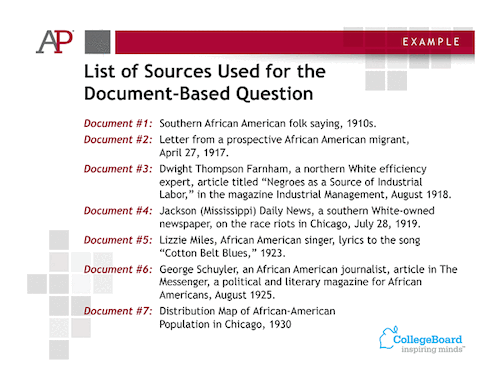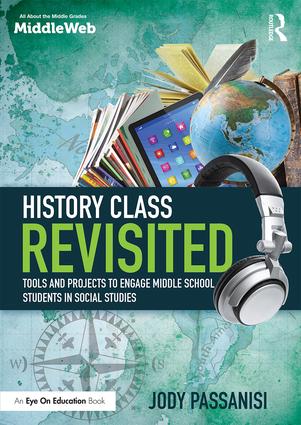Essay Writing in Middle School History Class
A MiddleWeb Blog

The main purpose of school is to prepare children to be successful after school. Everyone talks about our “digital age” and the shifts in education it necessitates. One shift is abundantly clear: written communication has never been as important as it is now.
When we were in school, people communicated differently – people actually talked on the phone. Now, thanks to texting, email, blogs, etc., more and more communication happens through writing.
The nature of writing is changing as well. People are rapidly scrolling through newsfeeds and scanning for interesting articles. If you want your ideas to be read, you have to get to the point quickly. And if you make grammar errors, or state something that is factually incorrect, you will be judged instantly – in a very public way.
In our own teaching, we’ve always maintained that writing is an essential skill for middle schoolers to develop. Whether your classroom is project based, inquiry based, student-centered, teacher-driven or lecture-style, your students are going to need to learn to express their understandings, evaluation, and synthesis through writing.
And not just any writing, but writing that is clear, cogent, concise, backed-up with research and facts, and well argued.
Scaffolding the Writing Experience
Middle grades students are asked to do more with their writing than we were as students. Today, summaries and reporting on facts are seldom enough; standards speak to evaluation, analysis, and synthesis. Advances in technology are helping to move writing in these directions, giving students the capacity to quickly revise their work from first to final draft, without tediously copying multiple versions.

With this advance in expectations comes an increased need for scaffolding the learning process. Some students find these demands for higher orders of thinking and writing very challenging, to say the least. They are adolescents, still moving from concrete to formal operations in the Piagetian sense, and will often need our support with their writing.
The Five-Paragraph Essay
Throughout our teaching careers, integrating writing skills – and having students demonstrate understanding of content through writing – has been a priority. But we haven’t always done it the same way.
When we first started teaching social studies in middle school, we used a five-paragraph essay. We provided the students an outline so that they could learn the important components of the format (intro, thesis, supporting paragraphs, transitions, conclusion – for example, this essay organizer on the Constitution). The essays were evaluative, and the students were required to use evidence from specific readings and notes that had been introduced and worked through during class.

As time passed, we began to ask our students to be more accountable for the sources they used, as Jody wrote about last year in this MiddleWeb piece on using citations in history. Even so, at the end of each unit, students continued to use our five-part outline to showcase their writing, their ability to synthesize, and their knowledge of the historical content that we had just explored.
While this organizing tool helped some students structure their ideas into some impressive essays, we came to see that it was masking some students’ writing deficiencies. Though the final product (after multiple revisions) often appeared to include high level thinking and deep comprehension, the amount of teacher guidance and outside help that some students received made us doubt the integrity of the assignment, and whether it was a true assessment of student comprehension and ability.
We began to wonder if timed writing events, where student writing skills would be “unmasked,” might add an important formative assessment element.
The Essay Under Time Constraints
Timed writing is by no means new, but it is seeing a resurgence in the high schools where our students often matriculate. In history class these timed writings are based on a few primary or secondary source documents (or a mixed grouping of both) and students are asked to make an evaluative statement about a historical period or concept using the evidence given.
DBQs, or Document Based Questions, have also been around awhile (in AP courses, for example). But again, they are increasingly becoming a primary way to procure evidence of student understanding – evidence of students’ ability to read, comprehend, synthesize, organize, and evaluate evidence “like historians” through their own writing.

Timed writings don’t always have to be DBQ based. At the end of a project-based learning unit, Jody used a timed writing to see if students were able to synthesize the varied information they had learned about the causes of the Civil War into an evaluative and succinct four paragraph essay that was written over a class period.
Students were asked to answer the question “What Caused the Civil War?” with a clear thesis, evidence, and citations, culminating in a conclusion that got to a “so what?” point. While this was a challenge, most students were able to demonstrate understanding with clear writing. The feeling of self-efficacy gained in timed writings in middle school will carry over to high school when students are tasked with a similar writing assignment – to write quickly and clearly and convey something important to the reader.

There will be some students who have special needs or Individualized Education Plans who may need a great deal of additional support and possibly much more time than other students in the class, but the exposure to timed writing, if it is done with a learning rather than “testing” vibe, can help each and every student to reach a personal goal, even if that goal is modified.
Teachers can help all students to lower their affective filter in writing simply by exposing them to the timed writing process. We believe this exposure will help them a great deal in their academic careers.
What’s Next?

What’s next for middle grades writing in social studies? The push for writing analytically is an important one, and one that will only help students be able to navigate the past in a more critical way. Gaining advanced writing skills will also impact their present, empowering them to articulate their views in more meaningful language.
How do you use writing in the social studies classroom?

































“When we were in school, people communicated differently – people actually talked on the phone.”
You’ve understated the difference. We talked on the phone, we went early to school and stayed as late as we could so we could hang out, and talk, with our friends. One of the most frequent problems was talking in class.
English survived as a language because of its strong oral tradition, from Beowulf to surviving 300 years of French rule following the Norman Conquest. But out of this English illiteracy came a renaissance of writing and literature, still anchored in an oral tradition that was in itself a conglomeration of invaders from the Vikings to the Danes, the Britons, the Romans, the Angle, Saxons, and Jutes, and finally William’s conquer of England which ended a very limited literacy on the island.
It was the strong oral tradition that incorporated the past tradition with the French and gave birth to what is modern English.
Usage is king. No matter what efforts are made to the contrary, usage will prevail. That is the significance of the change you’ve identified; it’s been less than 500 years ago we were an oral based culture, and now we are solidifying that change as we text rather than talk, email rather than call on the phone, and this has pushed the pendulum in the other direction, as we recognize the need for critical thinking and writing.
But at what cost? Is the ability to communicate using the spoken word still important? We don’t use it to text, email, use the computer, it doesn’t have spell check, and there is no “undo” button. It’s easy to make a mistake whole speaking, and these days, when you make a mistake, you find your err as a viral video all over the Internet.
I’m not arguing anything you’ve said, only concerned by what seems to be an increasing isolation of the writer and perhaps the need for balance in a culture that is increasingly a written tradition at the expense of the oral tradition.
Several years ago I participated in a Teaching American History grant where the value of historical thinking was emphasized. I learned the value of using primary documents to spur such thinking. Fortunately, we were also shown methods to teach our students how to evaluate and compile information in a clear and coherent essay. The two Chicago teachers that created the DBQProject.com understood first-hand how to teach these methods. I still consider it the most useful professional development I have ever received as an educator. It is a great resource for the skills you mentioned above. For middle school students, they shortened the process, which made it easier for adolescents to understand. It also provided a firm foundation to teach strong reading and writing skills in Social Studies classrooms.
After coordinating many of these strategies on the 7th/8th grade levels, my 8th graders are now able to answer one essential question from a chapter/unit with a well-organized and descriptive essay. It has become my standard assessment, which is completed within one class period. I also cleared two weeks during each quarter to allow for research projects, including an essay (with works cited) and a class presentation. I agree… don’t throw the 5-paragraph essay out the window yet. Writing must be taught via effective methods and with support. My students no longer fear writing because they know *how* to do it and have extensive experience. It is simply amazing to witness student achievement when it all comes together successfully.
Great resource — check out http://www.Awesomestories.org–
It s a free archive of contextual “stories” containing primary source evidence/extensions of the stories. You can sign up for the premium version to assign writing to students, to write multimedia stories yourself to use with your class.
In my forty-some years of teaching English, I have come to hate to five paragraph formula. It teaches students to think formulaically, to write repetitively, and to not be concerned with audience, purpose or voice. It becomes a kind of fill-in-the-blank kind of writing. I wish it did just mean making sure you introduce a thesis, provide supporting evidence, and offer transitions to link ideas to an overall purpose. But that is just writing. Yes, let’s teach that–which is just argument–rather than a formula that stipulates how you introduce a topic (not a thesis), repeating ideas–and probably language–from the introduction in each part of the body, and then repeating them again in the conclusion. Deadly.
But isn’t fill the blank – what you actually do fill into the blank – isn’t that where the meaning is? Not in the format? Who cares if format is 5 paragraphs or a blog or free verse – I’m curious what the content is – not what the structure is (as long as structure makes sense to me as a reader and I can follow the thinking). I dislike formulaic writing but not the shape – the content. I don’t want boring, empty words in any form, five paragraph or otherwise. But I’ll take deep, rich thinking in any form too – five paragraph is fine if the content written is amazing. It’s the content not the form I care about. Shakespeare didn’t say “Sonnet form is formulaic. Everyone uses it when they write a Sonnet.” He used the formulaic structure of Sonnet, but breathed his own life into the content.
Hi everyone! I hope you are enjoying your summer! My name is Jo-Ann Slater. I am a 7th grade Middle School Social Studies teacher. I am currently working on a school improvement project and my main focus is incorporating more rigor into the classroom. I am looking for any resources that are available for helping students to improve with writing.They will be conducting a research project of their choosing this fall. I will also post all of the resources that I have obtained over the years. Thank you for your help in advance!